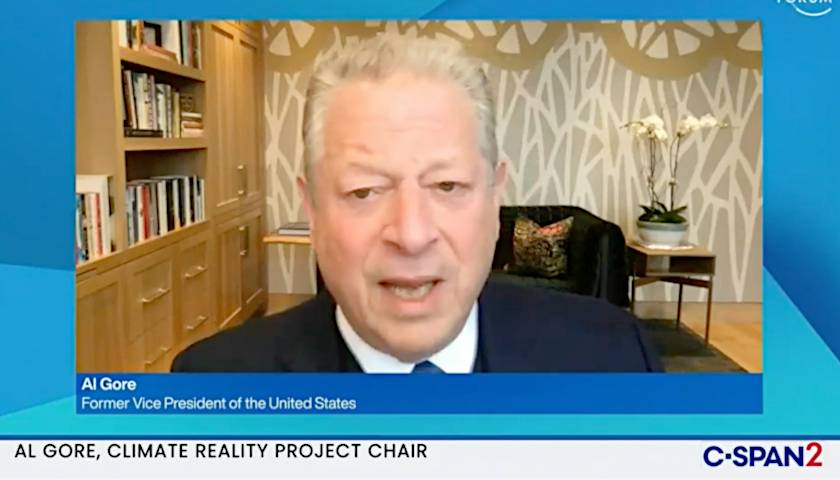by Carl M. Cannon
Forty-five years ago today, future vice president Albert Gore Jr. stood in the well of the House of Representatives to discuss an innovative development in television programming. There was nothing remarkable about that in itself: Al Gore had been a newspaperman before becoming a Tennessee congressman and had a genuine interest in both new technology and mass communication.
Except that there was something momentous about Gore’s speech that day. It was the first time that remarks delivered on the House floor by a member of Congress were televised. It was an event long envisioned by a 38-year-old Indiana-born, Purdue-educated, U.S. Navy veteran who had worked as a White House and Capitol Hill aide before returning to journalism. His name was Brian Lamb. As the Washington bureau chief of the trade publication Cablevision, Lamb had dreamed of creating a nonprofit cable network that would focus exclusively on public affairs, particularly Congress. It was called C-SPAN, and on March 19, 1979, that dream became reality.
Addressing an audience that Lamb later quipped was “in the thousands,” Al Gore said this: “The marriage of this medium and of our open debate have the potential, Mr. Speaker, to revitalize representative democracy.”
Precisely four and a half decades later, C-SPAN is still shining a spotlight on our nation’s elected representatives and our shared national history, even as the technology changes under the network’s feet (yet again.)
From the opening seconds of what would become C-SPAN’s uninterrupted odyssey of gavel-to-gavel coverage of the United States Congress, even a casual viewer could see that this was something different. Not low-budget production values exactly, because there was nothing cheap about the network’s lighting or cameras. It is more properly understood as low-hype values, the opposite ethos of commercial television.
C-SPAN’s sensibilities, which have changed little, can be gleaned from viewing the first few minutes of its broadcasting. It shows the entry door to the chamber, the chaplain opening the March 19, 1979, session with prayer, and House Speaker Thomas P. “Tip” O’Neill Jr. recognizing a young, thin, handsome Al Gore.
There were reasons for the no-frills C-SPAN approach, one of them being necessity: The network had only four employees when it first went on the air, far too few to get fancy. More importantly, Brian Lamb had promised O’Neill and his lieutenants that their approach would convey a seriousness of purpose. Lamb had no desire to imitate the networks’ glitzy approach, anyway, as the cable industry, not the government, was footing the bills, and still does – at least for now.
Why do I add that caveat? Well, in this fast-moving world of ours, an innovation that is two generations old – human generations, I’m talking about, not technological generations – must find ways to adapt. As C-SPAN came into its own, so did Millennials and Gen Zers. These two cohorts, especially the latter, are “cord-cutters,” which has obviously trying implications for the cable companies. Will they adapt? I, for one, hope so.
Certainly, C-SPAN is trying to stay relevant. As C-SPAN media relations specialist Robin Newton noted in a press release this week, “Over the years, we’ve grown to be so much more: on TV, online, on radio, our mobile app (C-SPAN Now), our connected TV app (C-SPAN Select), through podcasts and on social platforms (YouTube, Twitter, Facebook, Instagram, TikTok).”
And Robin added this important point: “We supplement live coverage of the Capitol with ideologically balanced programming concerning all manner of public policy and politics. In so doing, we promote open and transparent dialogue between the public and their elected and appointed officials – and those campaigning for office.”
That’s what we strive for at RealClearPolitics, too, which in part explains my well-documented affinity for C-SPAN. To me, the most unnerving change in the media in the past 45 years isn’t technological, although technological developments have accelerated it. The most destructive trend is the movement toward open partisanship in the media and, along with it, journalists’ encouragement of both private and government censorship – sometimes by the media itself.
In a weekend primer on Murthy v. Missouri, a landmark First Amendment case, the New York Times expressed sympathy for the censors, instead of those whose political speech was being muzzled. Donald Trump is the pretext, but this attitude represents a sea change, and in my view, a very dangerous one.
The Missouri censorship case was argued at the Supreme Court yesterday, and though Brian Lamb and his executive team have not persuaded the high court to allow cameras inside, C-SPAN’s efforts in this regard did produce radio coverage, which is better than nothing. Today, anyone with a laptop can listen to yesterday’s oral arguments here.
As I write these words, I’m not watching MSNBC, although I’m confident that Joe Scarborough and his band of partisans are gleefully attacking Trump or whatever other Republican caught their attention yesterday. And I see by scrolling through the cable stations that Newsmax is underwriting its programming at this very moment by airing – you can’t make this stuff up – an advertisement to buy $2 bills with Donald Trump’s mug (I didn’t say mug shot) on them in place of Thomas Jefferson’s.
Instead, I’m tuned into C-SPAN “Washington Journal,” where Pedro Echevarria is calmly interviewing STAT writer Lev Facher on the issue of opioids. It’s informative, and commercial-free, although I’m told that when you’re watching C-SPAN online (and I assume this is also true for RealClearPolitics) that the media outlet isn’t reimbursed unless you watch the entire ad. So keep that in mind today, whether you’re reading RCP elections analyst Sean Trende parse the polls or watching John McArdle interview James Swanson on C-SPAN’s American History TV about the manhunt for John Wilkes Booth.
So thank you, Brian Lamb, and the entire C-SPAN crew.
– – –
Carl M. Cannon is the Washington bureau chief for RealClearPolitics and executive editor of RealClearMedia Group. Reach him on Twitter @CarlCannon.
Image “Al Gore on C-SPAN” by C-SPAN.



